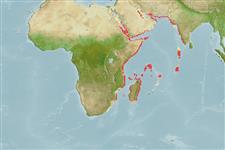>
Mulliformes (Goatfishes) >
Mullidae (Goatfishes)
Etymology: Upeneus: Greek, ypene, -es = upper lip (Ref. 45335); heemstra: Named for Phil and Elaine Heemstra..
Environment: milieu / climate zone / depth range / distribution range
Ekologi
laut dasar (demersal); kisaran kedalaman 0 - 12 m (Ref. 95469). Tropical
Western Indian Ocean: Mozambique to Central Red Sea, Seychelles, W India and Sri Lanka,
Size / Weight / umur
Maturity: Lm ? range ? - ? cm
Max length : 15.0 cm SL jantan/; (Ref. 95469)
deskripsi pendek
Kunci identifiaksi (pengenalan) | Morfologi | Morfometrik
Duri punggung (Keseluruhan (total)) : 8; duri punggung lunak (Keseluruhan (total)) : 9; Duri dubur: 1; Sirip dubur lunak: 6. This species is distinguished by the following characters: D VIII + 9; pectoral-fin rays 12-14; gill rakers 4-8 + 14-18 = 19-24; lateral-line scales 28-30; in %SL: body depth at first dorsal-fin origin 22-26; body depth at anal-fin origin 19-23; caudal-peduncle depth 9.5-11; caudal-peduncle width 2.9-4.6; maximum head depth 19-22; head depth through eye 14-17; head length 27-31; postorbital length 10-13; orbit length 6.3-8.3; upper jaw length 9.8-13; barbel length 15-20; caudal peduncle
length 21-23; caudal-fin length 27-30; anal-fin height 16-19; pelvic-fin length 20-22; pectoral-
fin length 19-21; pectoral-fin width 3.7-4.9; first dorsal-fin height 19-23; second dorsal-fin height 17-18; postorbital length 1.4-1.8 times in anal-fin height; colour of all fins with red, brown or black
stripes, bars or blotches; caudal fin with 9-12 oblique bars, 4-6 bars on upper caudal-fin lobe
and 5-6 bars on lower caudal-fin lobe; first dorsal fin possess a large blotch around tip; one pale- or dark brown mid-lateral body stripe from tip of snout through eye to caudal base; body and head ground colour white or beige, slightly darker above lateral line, with irregular red, brown or black spots and/or blotches; fresh specimens with yellow or pale brown barbels; fin and body pigmentation mostly retained in preserved fish (Ref. 95469).
Found over sand and mud bottoms near coral reefs (Ref. 30573); generally solitary (Ref. 5213). An invertebrate feeder (Ref. 41878).
Life cycle and mating behavior
Maturities | Reproduksi, perkembang biakan | Spawnings | Egg(s) | Fecundities | Larva
Uiblein, F. and G. Gouws, 2014. A new goatfish species of the genus Upeneus (Mullidae) based on molecular and morphological screening and subsequent taxonomic analysis. Mar. Biol. Res. 10(7):655-681. (Ref. 95469)
Status IUCN Red List (Ref. 130435)
ancaman kepada manusia
Harmless
penggunaan manusia
Alat, peralatan
laporan khas
muat turun XML
Sumber internet
Estimates based on models
Preferred temperature (Ref.
123201): 26.2 - 29.1, mean 27.6 °C (based on 601 cells).
Phylogenetic diversity index (Ref.
82804): PD
50 = 0.5000 [Uniqueness, from 0.5 = low to 2.0 = high].
Bayesian length-weight: a=0.00851 (0.00440 - 0.01645), b=3.08 (2.92 - 3.24), in cm total length, based on LWR estimates for this species & Genus-body shape (Ref.
93245).
Trophic level (Ref.
69278): 3.5 ±0.4 se; based on size and trophs of closest relatives
Daya lenting (Ref.
120179): Tinggi, Waktu penggandaan populasi minimum kurang dari 15 bulan (Preliminary K or Fecundity.).
Fishing Vulnerability (Ref.
59153): Low vulnerability (10 of 100).
